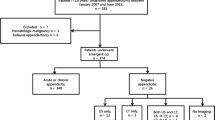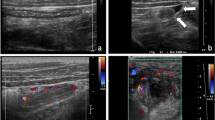Abstract
Background: The investigation of the acute abdomen in infants and children has evolved during the last two decades, placing imagers at the forefront of the evaluation and diagnosis of acute right lower quadrant abdominal problems. US and CT have recently been shown to be equally accurate in the diagnosis of acute appendicitis, but not everyone agrees. Objective: To demonstrate the efficacy of triaging patients with acute abdominal problems that suggest appendicitis with US as the primary imaging modality. Materials and methods: We retrospectively reviewed the prospective imaging diagnoses in 622 children who presented to our emergency room (ER) and clinics with acute abdominal symptoms suggestive of appendicitis. We documented whether US or CT was performed and noted the diagnoses made. All of the patients had plain films. In addition, all patients undergoing surgical appendectomy during this time were also documented so as not to miss any cases of appendicitis. None was missed. Results: There were 622 consecutive patients in our study. Three patients, diagnosed as normal, were eventually excluded because of lack of follow-up. In all, 152 patients were evaluated clinically and with plain films only. They were not subject to surgical exploration or further imaging. None returned with appendicitis. Eighty-one patients were directly subject to laparotomy after clinical and plain film evaluation. Of these patients, 20% had a normal appendix. Of the remaining 389 patients, 386 had US and three had CT alone. Four patients had both CT and US because of an inconclusive US examination. Three patients had CT alone because of their size. In total, 137 patients were diagnosed with appendicitis with US and/or CT. Four of these patients (3%) had normal appendices. Forty-two patients (less three lost to follow-up) were diagnosed as normal, and none returned with findings of appendicitis. Nine others had conditions other than acute appendicitis. Three had surgically proven, nonrelated conditions, and of the other six, one had pancreatitis and five nonsurgical adnexal problems. In all, 201 patients were diagnosed (with US) with mesenteric adenitis–enteritis, and none returned with findings of appendicitis. Conclusion: We attained a high degree of diagnostic accuracy in patients presenting with findings suggestive of appendicitis using US as the primary imaging modality. Our false-positive appendectomy rate was 3%. Therefore, triage of the acute abdomen with US supported by CT when required has considerable merit, especially when considering that US is noninvasive and does not use ionizing radiation.
Similar content being viewed by others
References
Carrico CW, Fenton LZ, Taylor GA, et al (1999) Impact of sonography on the diagnosis and treatment of acute lower abdominal pain in children and young adults. AJR 172:513–516
Diley A, Wesson D, Munden M, et al (2001) The impact of ultrasound examinations on the management of children with suspected appendicitis: a 3 year analysis. J Pediatr Surg 36:303–308
Fuhi Y, Hata J, Futagami K, et al (2000) Ultrasonography improves diagnostic accuracy of acute appendicitis and provides cost savings to hospitals in Japan. J Ultrasound Med 19:409–414
Hendrick EP, Chong-Han C, Swischuk LE, et al (1999) Accuracy of ultrasonography in acute right lower quadrant problems in children. Emerg Radiol 6:350–354
Rice HE, Arbesman M, Martin DJ, et al (1999) Does early ultrasonography affect management of pediatric appendicitis? A prospective analysis. J Pediatr Surg 34:754–759
Garcia BM, Taylor GA, Lund DP, et al (1999) Effect of computed tomography on patient management and costs in children with suspected appendicitis. Pediatrics 104:440–446
Grayson DE, Wettlaufer JR, Dalrymple NC, et al (2001) Appendiceal CT in pediatric patients: relationship of visualization to amount of peritoneal fat. AJR 176:497–500
Sivit CJ, Dudgeon DL, Applegate KE, et al (2000) Evaluation of suspected appendicitis in children and young adults; helical CT. Radiology 216:430–433
Sivit CJ, Applegate KE, Scallion A, et al (2000) Imaging evaluation of suspected appendicitis in a pediatric population: effectiveness of sonography versus CT. AJR 175:977–980
Poortman P, Lohle PM, Schoemaker CC, et al (2003) Comparison of CT and sonography in the diagnosis of acute appendicitis: a blinded prospective study. AJR 181:1355
Ford RD, Passinault WJ, Morse ME (1994) Diagnostic ultrasound for suspected appendicitis: does the added cost produce a better outcome? Am Surg 60:895–898
Martin AE, Vollman D, Adler B, et al (2004) CT scans may not reduce the negative appendectomy rate in children. J Pediatr Surg 39:886–890
Philpott JW, Swischuk LE, John SD (1997) Appendicitis in the era of ultrasound: are plain radiographs still useful? Emerg Radiol 4:68–71
Baechli D, Braun P (1978) Concomitant pneumonia and acute appendicitis in a child. Z Kinderchir 23:409–411
Gongaware RD, Weil R III, Santuli TV (1973) Right lower lobe pneumonia and acute appendicitis in childhood: a therapeutic disorder. J Pediatr Surg 8:33–35
Melamed M, Melamed JL, Rabushka SE (1967) Appendicitis: “Functional” bowel obstruction associated with perforation of the appendix. AJR 99:1112–1117
Riggs W, Parvey LS (1976) Perforated appendix presenting with disproportionate jejunal distention. Pediatr Radiol 5:47–49
Garcia BM, Mandl KD, Kraus SJ, et al (1999) Ultrasonography and limited computed tomography in the diagnosis and management of appendicitis in children. JAMA 282:1041–1046
John SD (2001) The use of advanced imaging for appendicitis in children. Emerg Radiol 7:331–338
van Breda Vriesman AC, Kole BJ, Puylaert JB (2003) Effect of ultrasonography and optional computed tomography on the outcome of appendectomy. Eur Radiol 13:2278–2282
Author information
Authors and Affiliations
Corresponding author
Rights and permissions
About this article
Cite this article
Hernandez, J.A., Swischuk, L.E., Angel, C.A. et al. Imaging of acute appendicitis: US as the primary imaging modality. Pediatr Radiol 35, 392–395 (2005). https://doi.org/10.1007/s00247-004-1372-8
Received:
Revised:
Accepted:
Published:
Issue Date:
DOI: https://doi.org/10.1007/s00247-004-1372-8




